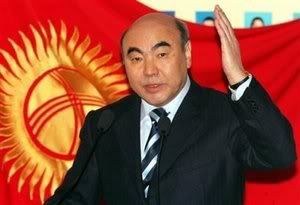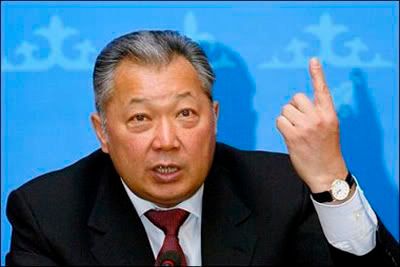The Path to a New Constitution in Kyrgyzstan: The Anatomy of a Political Crisis


Presidents Akayev and Bakiyev of Kyrgyzstan
For people who get their news from American newspapers and television, the protests that forced president Bakiyev to sign a new constitution this week appeared to come out of nowhere. Like most political developments of this kind, however, the frustrations and problems leading to change have a history, which, when viewed with hindsight, explain why what appear to be sudden transformations have taken place. The adoption of a new constitution in Kyrgyzstan is no different.
Kyrgyzstan has been in a political transition since 2003 when former president Akayev first announced that he would not seek re-election as president of the country. At that time, the former Soviet Union had not seen many democratic presidential successions, and Central Asia had never experienced one. As Akayev’s final term came closer and closer to an end, there was increased speculation that the presidential transition in Kyrgyzstan would follow one of the three models of transition seen in recent years in the former USSR: the “hand-off” model of Russia, the familial dynastic model of Azerbaijan, or the “colored revolution” model of Georgia and Ukraine.
Throughout late 2004 and early 2005, therefore, Kyrgyzstan was becoming increasingly polarized and few in the country believed that Akayev would anoint actual democratic elections for his successor. The Aksy tragedy of 2002, the establishments of super-presidential powers through the February 2003 constitutional referendum, and the increasing corruption within Akayev’s own family all led the opposition and various civil society actors to view the February 2005 parliamentary elections with speculation, especially when it became apparent that Akayev was facilitating the election of his son and daughter to the parliament. In general, it was believed that these elections were a prelude to a plan by Akayev to facilitate a non-democratic succession for the position of president that would protect himself, his family, and their combined influence in the country.
These were the conditions that led to the March 2005 overthrow of Akayev that has become known as the “Tulip revolution.” The “Tulip revolution,” however, did not represent the efforts of a consolidated political group or a real coalition of political parties, which are extremely weak in Kyrgyzstan. While the combined forces that were behind the protests forcing Akayev from office in March 2005 included many who were interested first and foremost in democratic change, others joined the movement with aspirations of usurping power. And, there was no clear organizational structure to the movement, which had arisen more organically (but also less cohesively) than the political party led ones in Georgia and Ukraine.
The government of Kurmanbek Bakiyev and Felix Kulov that emerged from the events of March 2005, therefore, came into power under the banner of democratic change, but it did not necessarily represent a consolidated democratic movement with a concrete agenda for how to bring that change about. Since Bakiyev’s official election as president in July 2005, he has been accused of re-creating many of the mechanisms of governance that characterized the rule of Akayev by carefully avoiding major reforms through deals with individuals inside the opposition and by allegedly re-creating a familial based system of patron-client relations as a means to run the country. While Bakiyev had yet to lose his legitimacy in the face of the country’s population to the degree that Akayev had by March 2005, his rule by this September was increasingly facing challenges from others who wanted to destroy his developing patron-client based system of rule and to initiate reforms.
This was the context in which opposition leader and parliamentarian Omurbek Tekebayev was arrested in early September of this year in a Warsaw airport for possession of heroin. What happened from there is in the following posts that have appeared on this website:
- September 7:
More Trouble with the Tulip Revolution: Kyrgyz Oppositionist Omurbek Tekebayev arrested in Warsaw
- September 8:
Update on the Tekebayev incident and Events in Kyrgyzstan
- September 8:
The Tekebayev video from Manas airport in Bishkek
- September 11:
Why would Astana request that Interpol search Tekebayev?
- September 12:
Bakiyev’s brother allegedly behind provocation against Tekebayev: Will Bakiyev save himself again or will the Tulip Revolution turn into poppy dust?
- September 15:
The Political Bazaar in Kyrgystan is Open Again: regardless of who framed whom, there are bound to be some new deals on the horizon
- September 18:
Kyrgyzstan Opposition "Kurultay" Takes Place in Aksy
- October 1:
Kyrgyz Opposition call for Public Protest on November 2: Is Time Running Out for Bakiyev?
- October 3:
Kyrgyz Opposition Increasing Pressure on the Bakiyev-Kulov Tandem
- October 6:
Is the Kyrgyz Opposition Splitting over Felix Kulov?
- October 12:
Will Bakiyev Save Himself Through Dialogue (Again)?
- October 17:
Is the Kyrgyz Opposition Trying to Pull Kulov Away from Bakiyev in Advance of the November 2 Protests?
- October 25:
All eyes on Kulov and Bakiyev: Where will Kyrgyzstan be Next Week at This Time?
- October 28:
A Big Week in Central Asian News: Three Events Will Demonstrate the Variety in the Region's Political Development
- November 2:
Countdown to Kyrgyz “Maydan,” the Sequel? (Part I)
- November 3:
Kyrgyz "Maydan," the Sequel (Part 2) - Photos from Day One
- November 3:
Kyrgyz "Maydan," the Sequel (Part 3) – Day One
- November 4:
Kyrgyz “Maydan,” the Sequel (part 4): Kyrgyz Protests Hankering Down for the Long Term?
- November 5:
Kyrgyz “Maydan,” the Sequel (Part 5): Public Television and Constitution Remain Sticking Points in Kyrgyzstan’s Political Stand-off
- November 6:
Kyrgyz “Maydan,” the Sequel (Part 6): Have Bakiyev and Kulov Backed Themselves into a Corner?
- November 6:
Kyrgyz “Maydan,” the Sequel (Part 7): Does Kyrgyzstan Await a New Constitution or Violence Today?
- November 7:
Kyrgyz “Maydan,” the Sequel (Part 8): Showdown of Protesters in Bishkek?
- November 7:
Kyrgyz “Maydan,” the Sequel (Part 9): Is a Compromise Within Reach?
- November 8:
Kyrgyz “Maydan,” the Sequel (Part 10): Are Bakiyev and Kulov Trying to Pull A Fast One?
- November 8:
Kyrgyz “Maydan,” the Sequel (Part 11): The Ping-Pong of Kyrgyzstan’s Political Crisis…Will President Bakiyev Sign the New Constitution?
- November 9:
Kyrgyz “Maydan,” the Sequel (Part 12): Bakiyev Signs Compromise Version of Constitution and Political Crisis is Averted, But for How Long?)
As this background to Kyrgyzstan’s ongoing political crisis suggests, the problems behind it have yet to be fully resolved. The country, like most of the former U.S.S.R., has yet to shed its reliance on a patron-client system of power that has been present since the Soviet period. Kyrgyzstan, and most of the former U.S.S.R., also lacks the checks and balances in governance that are needed to mitigate this reliance on patron-client relations and provide for stable transitions of power. Like Georgia and Ukraine, however, Kyrgyzstan continues to struggle with ways to break out of the cycle of patron-client relationships that characterize its political terrain. While it is unclear how much the new constitution adopted this week will resolve this problem, it at least demonstrates that many in Kyrgyzstan are seeking means to change their country’s system of governance and establish stability through reform. It won’t be an easy road, but neither was that which the founding fathers of American democracy undertook in the late eighteenth century.



9 Comments:
The events of the past week have shown that true democracy has taken hold in Kyrgyzstan. That wasn't clear in 2005, when widespread discontent with the corrupt Akayev regime led to his ouster and the accidental rule of Bakiyev. This time, the agenda is broader and much better defined: it is not about simply replacing a corrupt president. The demonstrations were well organized, largely free of violence and the looting that took place in 2005. Opposition politicians, civil society, and the public have united. Watch for the rise of Tekebaev and, finally, the end of the Kulov myth.
Bakiyev was elected president on 10 July 2005, not in December
Naryn,
Rakhmat. I mixed up the dates...guess I did too many election observations last year, and they are all starting to blend together. I changed it in the post.
I would add to the Akaev theories, the very prevalent belief that he would engineer a weaker Presidency and come back himself as a strong Prime Minister.
In my opinion everyone may browse on this.
Get huge benefits in commodity market just by using valuable Commodity tips from a reputed firm Epic Research.
All researched details used and current in the custom research paper must be arranged in a rational and organized way. This will be useful to readers who do not have the same academic track record as the writer.
Rakhmat. I mixed up the dates...guess I did too many election observations last year, and they are all starting to blend together. I changed it in the post., mcx free tips
Good reading this posst
Post a Comment
<< Home